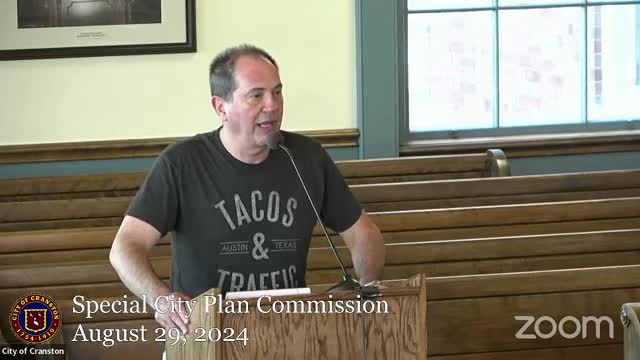Cranston resident advocates for improved public transport and solar initiatives
August 30, 2024 | Cranston City, Providence County, Rhode Island
This article was created by AI summarizing key points discussed. AI makes mistakes, so for full details and context, please refer to the video of the full meeting. Please report any errors so we can fix them. Report an error »

During the City Plan Commission Comprehensive Plan Public Hearing held on August 29, 2024, in Cranston, Rhode Island, community members voiced critical concerns regarding the city’s transportation and energy strategies. The discussions highlighted the need for improved public transit, better infrastructure for non-motorized transport, and a more comprehensive approach to solar energy utilization.
One of the key topics raised was the inadequacy of public transportation options in Cranston. A resident emphasized the necessity for a cross-town bus service, noting that current travel across the city requires a car, which is not feasible for all residents. This lack of public transit options contributes to increased traffic congestion, particularly during winter months when parents drive their children to school due to unsafe sidewalks. The resident pointed out that the city’s snow removal efforts focus primarily on roads, leaving sidewalks neglected and creating hazardous conditions for pedestrians.
The conversation also turned to the city’s approach to solar energy. A participant criticized the Comprehensive Plan's Chapter 9 for its heavy emphasis on traffic management while neglecting the potential of existing rooftops for solar panel installation. They argued that every roof, regardless of orientation, could be suitable for solar energy, especially given Rhode Island's high electricity rates. The resident called for a "fill the roof law" to facilitate community solar initiatives, which they believe are currently hindered by restrictive regulations from Rhode Island Energy.
Additionally, the discussion touched on the characterization of Cranston's neighborhoods. Concerns were raised about the classification of East Cranston as urban and West Cranston as agricultural, with residents asserting that much of the city remains suburban or rural. This mischaracterization could impact future development plans and zoning regulations.
The meeting underscored a broader need for Cranston to rethink its transportation and energy policies to better serve its residents. As the city grapples with these challenges, the feedback from the public hearing will likely play a crucial role in shaping the Comprehensive Plan moving forward. The next steps will involve addressing these concerns and potentially revising the plan to incorporate more sustainable and accessible solutions for all residents.
One of the key topics raised was the inadequacy of public transportation options in Cranston. A resident emphasized the necessity for a cross-town bus service, noting that current travel across the city requires a car, which is not feasible for all residents. This lack of public transit options contributes to increased traffic congestion, particularly during winter months when parents drive their children to school due to unsafe sidewalks. The resident pointed out that the city’s snow removal efforts focus primarily on roads, leaving sidewalks neglected and creating hazardous conditions for pedestrians.
The conversation also turned to the city’s approach to solar energy. A participant criticized the Comprehensive Plan's Chapter 9 for its heavy emphasis on traffic management while neglecting the potential of existing rooftops for solar panel installation. They argued that every roof, regardless of orientation, could be suitable for solar energy, especially given Rhode Island's high electricity rates. The resident called for a "fill the roof law" to facilitate community solar initiatives, which they believe are currently hindered by restrictive regulations from Rhode Island Energy.
Additionally, the discussion touched on the characterization of Cranston's neighborhoods. Concerns were raised about the classification of East Cranston as urban and West Cranston as agricultural, with residents asserting that much of the city remains suburban or rural. This mischaracterization could impact future development plans and zoning regulations.
The meeting underscored a broader need for Cranston to rethink its transportation and energy policies to better serve its residents. As the city grapples with these challenges, the feedback from the public hearing will likely play a crucial role in shaping the Comprehensive Plan moving forward. The next steps will involve addressing these concerns and potentially revising the plan to incorporate more sustainable and accessible solutions for all residents.
View full meeting
This article is based on a recent meeting—watch the full video and explore the complete transcript for deeper insights into the discussion.
View full meeting